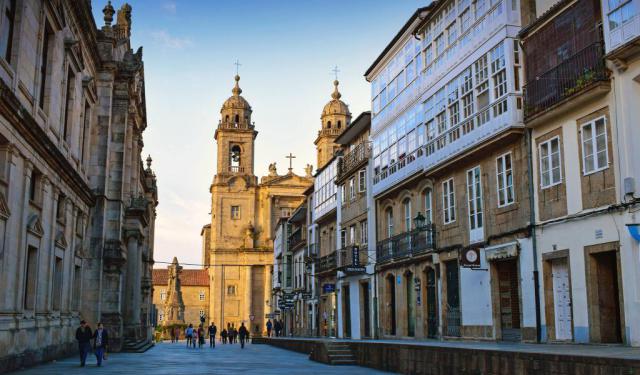
Rúa Nova (New Street), Santiago de Compostela
The New Street, located in the historic center of Santiago de Compostela, is a street of great significance and one of the city's most emblematic thoroughfares. Running parallel to Vilar Street, it is renowned alongside another famous street, Franco Street, for its bustling atmosphere and the continuous flow of people passing through. The key reason behind this popularity is its direct connection to the Cathedral of Santiago de Compostela.
The New Street holds a historical charm that reflects its past as part of the old city. Its present appearance is characterized by the distinctive arcades that adorn a significant portion of Santiago's old town. In the past, these arcades were the site of a vibrant daily market where a variety of goods, including clothing, were sold. Alongside the market, a diverse array of shops lined the street, offering different types of products. The street acquired its name in the 12th century, and it is home to some of the city's most iconic landmarks.
Notably, the New Street houses the main theater of Santiago and the Galician Dramatic Center. Additionally, visitors can explore the Church of Santa María Salomé, the only church dedicated to the mother of the Apostle in Santiago de Compostela. Furthermore, one can access the Santa Cruz Palace, a 19th-century building that provides a glimpse into the city's architectural heritage. For those seeking more enchanting sights, Casa das Pombas, constructed in the 17th century, offers a captivating experience. Book lovers can also indulge in the Vetusta bookstore, a renowned establishment considered an icon within the old town of Santiago de Compostela.
The New Street holds a historical charm that reflects its past as part of the old city. Its present appearance is characterized by the distinctive arcades that adorn a significant portion of Santiago's old town. In the past, these arcades were the site of a vibrant daily market where a variety of goods, including clothing, were sold. Alongside the market, a diverse array of shops lined the street, offering different types of products. The street acquired its name in the 12th century, and it is home to some of the city's most iconic landmarks.
Notably, the New Street houses the main theater of Santiago and the Galician Dramatic Center. Additionally, visitors can explore the Church of Santa María Salomé, the only church dedicated to the mother of the Apostle in Santiago de Compostela. Furthermore, one can access the Santa Cruz Palace, a 19th-century building that provides a glimpse into the city's architectural heritage. For those seeking more enchanting sights, Casa das Pombas, constructed in the 17th century, offers a captivating experience. Book lovers can also indulge in the Vetusta bookstore, a renowned establishment considered an icon within the old town of Santiago de Compostela.
Want to visit this sight? Check out these Self-Guided Walking Tours in Santiago de Compostela. Alternatively, you can download the mobile app "GPSmyCity: Walks in 1K+ Cities" from Apple App Store or Google Play Store. The app turns your mobile device to a personal tour guide and it works offline, so no data plan is needed when traveling abroad.
Rúa Nova (New Street) on Map
Sight Name: Rúa Nova (New Street)
Sight Location: Santiago de Compostela, Spain (See walking tours in Santiago de Compostela)
Sight Type: Attraction/Landmark
Guide(s) Containing This Sight:
Sight Location: Santiago de Compostela, Spain (See walking tours in Santiago de Compostela)
Sight Type: Attraction/Landmark
Guide(s) Containing This Sight:
Walking Tours in Santiago de Compostela, Spain
Create Your Own Walk in Santiago de Compostela
Creating your own self-guided walk in Santiago de Compostela is easy and fun. Choose the city attractions that you want to see and a walk route map will be created just for you. You can even set your hotel as the start point of the walk.
Santiago de Compostela Introduction Walking Tour
Legend has it that after Saint James, one of the Twelve Apostles of Jesus, was martyred in Jerusalem in 44 AD, his followers carried his decapitated body by sea to Spain. Others claim that the saintly remains were miraculously taken up by angels and sailed to the coast of Galicia, where a massive rock closed around it and was later moved to its final resting place.
Either way, during the... view more
Tour Duration: 2 Hour(s)
Travel Distance: 1.7 Km or 1.1 Miles
Either way, during the... view more
Tour Duration: 2 Hour(s)
Travel Distance: 1.7 Km or 1.1 Miles

